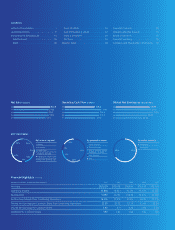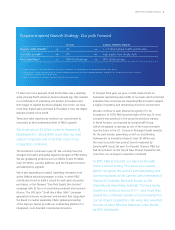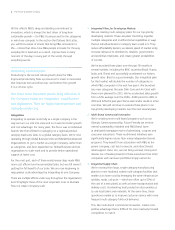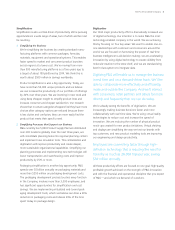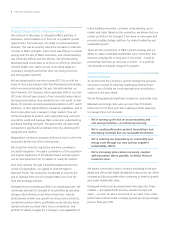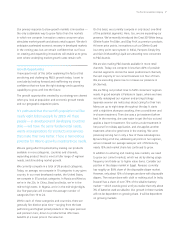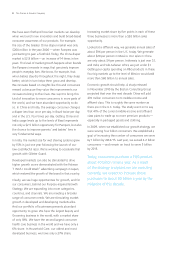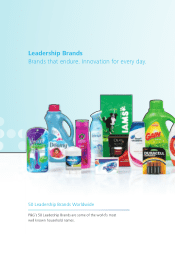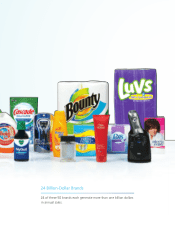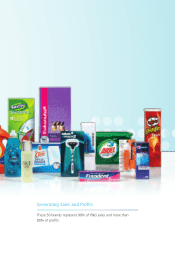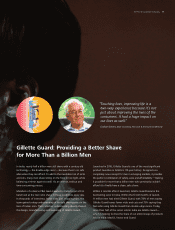Proctor and Gamble 2011 Annual Report Download - page 9
Download and view the complete annual report
Please find page 9 of the 2011 Proctor and Gamble annual report below. You can navigate through the pages in the report by either clicking on the pages listed below, or by using the keyword search tool below to find specific information within the annual report.
On this basis, we currently compete in only about one-third
of the potential segments. Here, too, we are expanding our
presence. We’ve recently introduced the Crest D White lineup,
Gillette Fusion ProGlide, and Olay ProX as premium products.
At lower price points, innovations such as Gillette Guard
(our entry point razor system in India), Pampers Simply Dry
and Gain Dishwashing Liquid are attracting new consumers
to P&G brands.
We are also making P&G brands available in more retail
channels. Today, we compete in less than 40% of possible
channel segments. Across the seven predominant channels,
the vast majority of our current business is in four of them.
We are executing plans now to increase our presence in
all channels.
We are filling out product lines to fulfill consumers’ regimen
needs. A good example is Pantene in Japan, where we have
recently redesigned our regimen and pricing strategy.
Japanese women are meticulous about caring for their hair.
Many use up to eight steps throughout the day. It starts
with a nighttime shampoo washing, then a conditioner and
in-shower treatment. Then she uses a jar treatment before
bed. In the morning, she uses water to get the frizz out and
applies a leave-in treatment. She carries a tube treatment in
her purse for midday application, and she applies another
treatment when she gets home in the evening. We were
previously serving her in only a few of these subcategories.
By launching a full line, addressing all points in her regimen,
we’ve increased our average sales per unit of Pantene by
nearly 15% and market share has continued to grow.
In addition to entering and creating new markets, we need
to grow our current markets, which we do by driving usage
frequency and trade-up to higher value items. Consider our
position in the diaper market in Egypt. Pampers currently
has roughly an 80% share of the disposable diaper market.
However, only about 10% of changes are done with disposable
diapers. The rest are done with cloth or nothing at all. In India,
Duracell has a share of over 75% of the alkaline battery
market—which sounds good, until you realize that only about
3% of batteries used are alkaline. Our growth in these markets
will not be dependent on growing share. It will be dependent
on growing markets.
Our primary response to slow-growth markets is innovation—
the only sustainable way to grow faster than the markets
in which we compete. Innovation creates consumer value,
stimulates market growth and attracts retail support. We don’t
anticipate accelerated economic recovery in developed markets
in the coming year, but we remain confident that our focus
on creating and expanding innovations will enable us to grow
even where underlying market growth rates remain soft.
Growth Opportunities
I have spent most of this Letter explaining the factors that
are driving and challenging P&G’s growth today. I want to
conclude by looking forward and reaffirming my strong
confidence that we have the right strategy and supporting
capability to grow well into the future.
The growth opportunities created by our strategy are clearest
when you look at population and economic growth trends
and our geographic expansion plans.
It’s estimated that the world’s population will be
nearly eight billion people by 2020. All these
people —in developed and developing countries
alike —will have the same fundamental needs,
wants and aspirations for products and services
that make their lives better. There is tremendous
potential for P&G to grow by meeting those needs.
We are going after this potential by making our products
available in more categories, countries and channels,
expanding product lines to meet a fuller range of regimen
needs, and stimulating market growth.
We currently compete in a total of 38 product categories.
Today, on average, we compete in 19 categories in any given
country. In our most developed market, the United States,
we compete in 35 product categories. In Russia and Mexico,
we’re in the20s. In China, Brazil and India, we’re in the
mid-to-high teens. In Nigeria, we’re in the mid-single-digits.
Our five-year plan will increase the average number of
categories from 19 to 24.
Within each of these categories and countries, there are
generally five distinct price tiers — ranging from the best
performing and highest priced products in the super premium
and premium tiers, down to products that offer basic
benefits at a lower price in the value tier.
The Procter & Gamble Company 7


